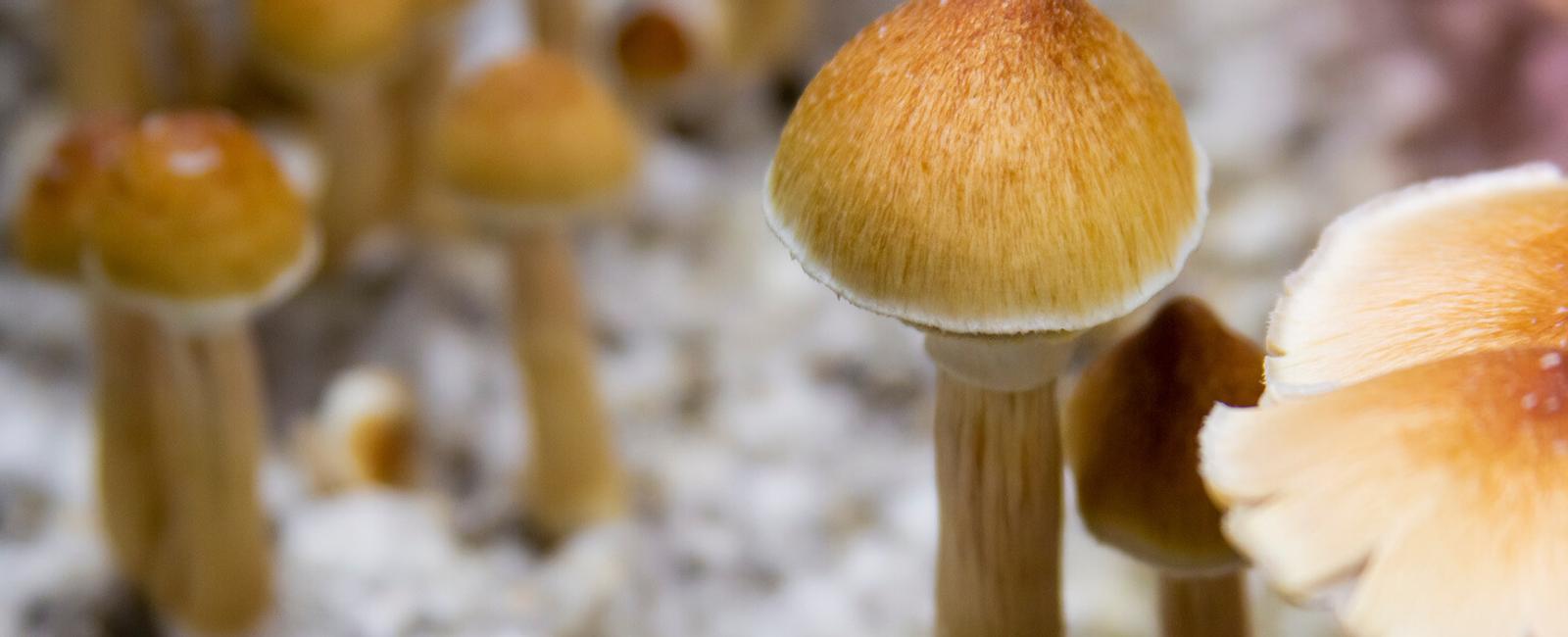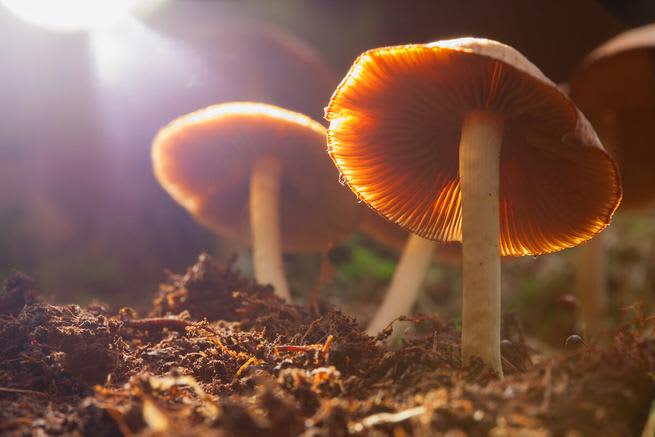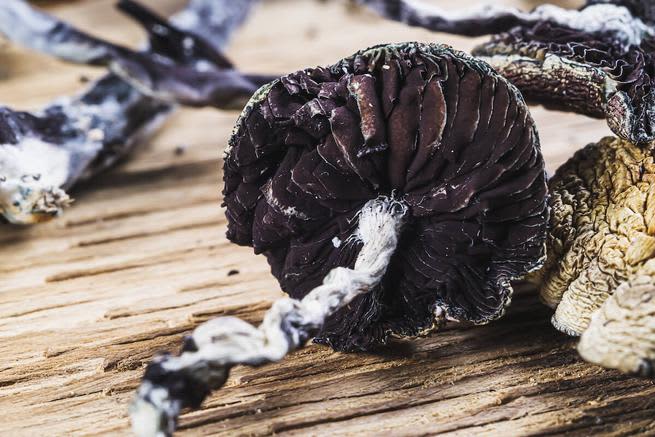

Psilocybe cubensis is, by far, the most famous species among psychedelic fungi. Known for their golden cap and distinctive size, “cubes” are a top choice among psychonauts looking to harvest magic mushrooms from the wild.
Yet, not many people know these mushrooms may have been around for more than 3,500 years. Mesoamerican cultures used magic fungi for religious and medicinal purposes—and modern research suggests they weren’t far off the mark. Here’s what you need to know about this incredible shroom.
What is Psilocybe cubensis?
Psilocybe cubensis is probably the most widespread species of psychedelic mushrooms worldwide. It usually grows in warm, wet subtropical climates all along America, Oceania, and Southeast Asia—although it’s also possible to find it in other parts of the world. It’s one of the largest and most distinctive species in the Psilocybe genus, making it easy to identify in the wild.
P. cubensis goes by many other names, including:
- Cubes
- Gold caps
- Golden tops
- Golden halos
- San isidros
- Shrooms (may also refer to other species)
- Magic mushrooms (may also refer to other species)
Despite its popularity, Psilocybe cubensis isn’t considered to be remarkably potent. In fact, experts point out it’s rather moderate when it comes to its psychoactive concentrations. Most of its popularity stems from the fact that it’s easy to find in the wild and that it’s the easiest magic mushroom species to grow at home.
If you’re looking for magic mushrooms with higher psilocin and psilocybin contents, we recommend you look into Psilocybe cyanescens (wavy caps) and Psilocybe semilanceata (liberty cap mushrooms).
As with the other species in the genus Psilocybe, the psychedelic properties of P. cubensis come from two compounds—psilocybin and psilocin. The two are closely related, as psilocybin is a precursor of psilocin, which is the actual psychoactive compound.
One of the most distinctive characteristics of P. cubensis and most other psilocybin-containing mushrooms is that they bruise blue whenever they’re damaged. This represents psilocin’s oxidation—although experts warn that this cannot be considered to be definitive proof for identification (1) (2).
How does Psilocybe cubensis look?

Psilocybe cubensis is one of the biggest species among psychedelic mushrooms, with its golden cap measuring 1.5–8 cm (0.6–3 in). Initially convex, the cap usually grows to be almost completely plane in older specimens. The white stem is rather long, typically measuring 4–15 cm (1.5–6 in).
The gills are narrow and close to each other, with a pallid color that turns nearly black once the mushroom matures. The famous blue bruising may appear in all parts of the fungus—although it’s more common in the stem. The spore print is dark purple to brown (1).
What are the varieties of Psilocybe cubensis?
Unfortunately, the age-old question of whether or not Psilocybe cubensis has any varieties hasn’t been answered yet.
Varieties (also sometimes referred to as strains) are defined among shroom lovers as a set variations within a species—somewhat akin to a race. While the concept is similar to the one used by expert mycologists, the psychedelic community clarifies that strains should also be able to significantly alter the psychedelic experience.
The whole idea of variations and strains has been heavily debated for years, but there still aren’t any definite answers. For the most part, there are two possible sides to the question:
On one end, some amateur mycologists claim that variations don’t exist, often using the phrase “a cube is a cube.” They believe that the different effect profiles of strains are nothing but a placebo, as there aren’t any significant chemical variations.
On the other hand, proponents of the different strains have cataloged over 20 variations, affirming that they have notable changes in their chemical balances. These people argue that such varying chemical compositions can alter the trip.
Science doesn’t recognize the different strains beyond a few passing mentions in some papers. This makes it even harder to find a proper chemical analysis of the variations (3) (4).
As such, it’s up to you to believe (or not) if strains actually exist. So far, the most common strains recognized by amateur mycologists are (5):
- Penis envy
- Golden teachers
- Cambodian
- Amazonian
- Equador
- Albino A+
- Treasure coast
- Mazatapec
Proponents of strains affirm that these variations will provide different experiences—for example, golden teachers are known to be more spiritual while penis envy are more visual. In any case, make sure you carefully measure your dose whenever you’re trying a new strain.
History of Psilocybe cubensis

Psilocybe cubensis mushrooms might be one of our oldest companions when it comes to the fungi world. These amazing mushrooms have been used for at least 500 years—but evidence suggests that ancient civilizations may have consumed cubes for far longer.
Experts point out that the consumption of hallucinogenic mushrooms was common in Mesoamerican cultures. From Mexico to the rest of Central America, Mayans consumed Psilocybe cubensis, which they called “k’aizalaj Okox,” during religious ceremonies. Other cultures, like the Aztecs and the Mazatecs, also used magic mushrooms for similar purposes (6).
Evidence suggests that magic mushroom use is at least 3,500 years old—however, the first official description of P. cubensis dates to the 16th century. At the time, a Spanish fray, Bernardino de Sahagún, wrote about hallucinogenic mushrooms in his book, Historia de las cosas de Nueva España.
There, he described how Aztecs consumed P. cubensis, which they called “teonanácatl,” to get religious visions and for medicinal purposes. Yet, for hundreds of years, the existence of these mushrooms was heavily debated due to a lack of evidence.
It wasn’t until 1936 that botanist Roberto Weitlaner was able to send specimens to Harvard to prove their existence. A few years later, in 1957, mycologist Gordon Wasson published his famous article “Seeking the Magic Mushroom” in Life Magazine. There, he chronicled how he found the mushrooms and sent them to Albert Hoffman (the same man who discovered LSD) for research (7).
Once Hoffman was able to confirm the psychedelic properties of P. cubensis, research has been focused on the medicinal properties of the species. Turns out that the Aztecs weren’t wrong about the potential of these wonderful fungi!
Health benefits of Psilocybe cubensis
Almost any psychedelic enthusiast knows that hallucinogenic mushrooms, such as P. cubensis, are one of the main focal points of modern psychology and psychiatry research. Through a technique known as psychedelic-assisted psychotherapy (PAP), experts have discovered the potential of shrooms in treating several mental disorders and conditions.
The first trials and theories regarding the therapeutic properties of magic mushrooms, LSD, n,n-dimethyltryptamine (DMT), and other psychedelics appeared around 1943 when LSD was discovered. Researchers believed that psychedelics could be particularly useful for tearing down some of the unconscious barriers of the mind.
In turn, they started experimenting (with varying degrees of success) on people with alcoholism and post-traumatic stress disorder (PTSD). However, research came to a sudden stop after the prohibition of most psychedelics in the late 1960s.
This severely hindered the theories behind PAP, as stigma and taboos surrounding these substances began to grow among the general public and scientific community.
It wasn’t until the 2010s that experts could once again get their hands on psychedelic substances—and, since then, research has grown stronger than ever. Modern papers confirm that psychedelics such as psilocybin could be one of our best tools for treating anxiety, depression, addiction, and PTSD. In fact, PAP proponents claim that psychedelics can be more effective and faster-acting than other current treatments (8) (9).
But there’s still a long way to go—despite these promising claims, researchers have yet to fully develop a theory that allows the complete introduction of psychedelics in modern psychotherapy.
It’s crucial to remember that hallucinogenic mushrooms aren’t a magic cure-all. You should never take psychedelics for self-therapy unless you’re under the close supervision of a professional.
Side effects of P. cubensis
The side effects of P. cubensis are pretty much the same as any other psychedelics, including both mental and physical effects. However, it’s important to know that not all people will get side effects from shrooms. The most common symptoms are (10):
- Paranoia
- Anxiety
- Mood changes
- Sweating
- Increased heart rate
As with other psychedelics, there’s also some risk of having a bad trip—a hallucinogenic experience that, for one reason or another, becomes terrifying. This may include undesirable visual and auditory distortions, seemingly unbreakable thought loops, and high levels of anxiety.
Still, psychedelic mushrooms are considered to be one of the safest psychoactive substances that we know of. While some of these side effects may sound harsh, most of them will go away a couple of hours after consuming the mushrooms.
Where does Psilocybe cubensis grow?

Psilocybe cubensis is a pan-tropical mushroom, meaning it prefers to grow in warm, humid climates. It’s possible to find it almost anywhere in the world, from southeastern Canada and warm states of the U.S. (think Georgia and California) to certain regions in Australia and Southeast Asia.
If you’re familiar with magic mushrooms, you’ll know that the most common advice when wildcrafting is to look for them near cattle after heavy rain. This is because P. cubensis—along with a few other psychedelic species—grows on the dung of bovines and horses when there’s a lot of humidity.
Experts claim that fruiting bodies tend to appear in the summer, although it’s possible to find them during spring as well.
A key characteristic of P. cubensis is that it can grow on almost any substrate when cultivated artificially. This makes it one of the easiest mushrooms to grow at home, only requiring the spores, a substrate such as grass or cereal straws, and some form of protein (1) (2).
What is ethical wildcrafting?
Ethical wildcrafting refers to the practice of harvesting natural resources without damaging the environment. This includes a set of guidelines to ensure you don’t harm the rest of the mushroom patch or other nearby species when picking wild fungi.
Wildcrafting is often confused with foraging—the key difference is that the former refers to harvesting resources for medicinal purposes while the latter for culinary ones. Here are some of the key rules for ethical wildcrafting:
- Do some research beforehand—take note of any endangered species that you may come across.
- Carry a field guide—these handy manuals can help you avoid poisonous lookalikes and teach you more about your local ecosystem.
- Be mindful regarding overharvesting—try not to take more than you need, and don’t disclose patch locations with others.
- Take care of the mushroom patch—pick the mushrooms gently, and only use scissors and knives when necessary.
- Pay attention to the legal side of things—ask for permission when you’re harvesting on private land, and check local wildcrafting laws when you’re on public land.
And, of course, make sure you’re aware of your local regulations regarding psychedelic mushrooms. Psilocybin and psilocin are banned in most countries, so wildcrafting for P. cubensis may have dire consequences.
Is it safe to wildcraft for Psilocybe cubensis?
Unfortunately, it’s never 100% safe to harvest and consume wild mushrooms. There’s always the risk of coming across a poisonous lookalike—no matter how experienced you are. Psilocybe species, for example, are often confused with the “deadly galerina” (Galerina marginata)—a highly toxic fungus that looks almost the same as P. cubensis.
Furthermore, wild mushrooms often carry toxins from the environment, which can lead to side effects such as gastric discomfort. As such, we recommend you look for local harvesting groups—most professional wildcrafters will gladly help you avoid these risks.
How do you take Psilocybe cubensis?

There isn’t a specific way to take P. cubensis or any other psychedelic mushroom. Instead, experienced psychonauts often recommend three primary options: powdered, dried, and fresh.
Fresh mushrooms are probably the least common way to take cubes, as their high water content makes it hard to consume large amounts of psilocybin and psilocin. Still, they may be useful for people who want to microdose—as long as you don’t mind the earthy taste.
Dried mushrooms, on the other hand, are probably the most common and easy way to take psychedelic fungi. Dried doses are about 90% smaller than their equivalent in fresh shrooms, allowing you to accurately consume high doses without having to eat dozens of mushrooms.
Last but not least, powdered mushrooms require some effort to make—but allow you to completely bypass the taste of P. cubensis. Most people add powdered shrooms to beverages and food, creating a delicious and discreet way to take their dose.
Psilocybe cubensis: Well-deserved fame
Psilocybe cubensis is the most famous species among psychedelic mushrooms. Its lax growth conditions have allowed it to spread all over the world—and make it one of the top choices for beginner fungi cultivators. To add to their fame, they may also be one of the oldest psychoactive mushrooms in human history.
If you want to find out about other types of mushrooms, keep up on shroomer. Here, you’ll find all the details you need about psychedelic and functional fungi from all over the world, along with the latest news on medicinal research on edible mushrooms.
References
- Paul Stamets, “Psilocybe cubensis” in Psilocybin Mushrooms of the World (1996), 108–111.
- L.G. Nicholas, Kerry Ogame, “Psilocybe: The Species” in Psilocybin Mushroom Handbook (2006), 20–26.
- Sanah Malomile Nkadimeng, Christiaan M L Steinmann, Jacobus N Eloff. “Anti-Inflammatory Effects of Four Psilocybin-Containing Magic Mushroom Water Extracts in vitro on 15-Lipoxygenase Activity and on Lipopolysaccharide-Induced Cyclooxygenase-2 and Inflammatory Cytokines in Human U937 Macrophage Cells.” Journal of Inflammation Research, 14 (2021): 3729–3738. https://doi.org/10.2147%2FJIR.S317182
- Sanah M. Nkadimeng, Christiaan M. L. Steinmann, Jacobus N. Eloff. “Effects and safety of Psilocybe cubensis and Panaeolus cyanescens magic mushroom extracts on endothelin-1-induced hypertrophy and cell injury in cardiomyocytes.” Scientific Reports, 10 (2020): 22314. https://doi.org/10.1038%2Fs41598-020-79328-5
- Shroomery. “Psilocybe Cubensis Strains.” No date. https://files.shroomery.org/cms/Psilocybe%20Cubensis%20Strains.pdf
- F.J. Carod-Artal. “Hallucinogenic drugs in pre-Columbian Mesoamerican cultures.” Neurología (English Edition), 30(1) (2015): 42–49. https://www.sciencedirect.com/science/article/pii/S2173580814001527?via%3Dihub
- David E. Nichols. “Psilocybin: from ancient magic to modern medicine.” The Journal of Antibiotics, Special Feature (2020). https://doi.org/10.1038/s41429-020-0311-8
- Eduardo Ekman Schenberg. “Psychedelic-Assisted Psychotherapy: A Paradigm Shift in Psychiatric Research and Development.” Frontiers in Pharmacology, 9 (2018). https://doi.org/10.3389/fphar.2018.00733
- Kenneth W. Tupper, Evan Wood, Richard Yensen, Matthew W. Johnson. “Psychedelic medicine: a re-emerging therapeutic paradigm.” Canadian Medical Association Journal, 187(14) (2015): 1054–1059. https://doi.org/10.1503/cmaj.141124
- “Psilocybin and psilocin (Magic mushrooms).” 2023. Canada.ca. https://www.canada.ca/en/health-canada/services/substance-use/controlled-illegal-drugs/magic-mushrooms.html#a2


